
What is the cost of employee turnover?
September 22, 2023
Reem Al-Tamimi
Content Writer
The cost of employee turnover imposes a significant burden on organizations. In addition to the direct cost of 1.5 to 2 times the departing employee’s salary, there exist hidden expenditures such as recruitment, onboarding, and productivity disruptions. Moreover, intangible drawbacks encompass diminished morale, disrupted team cohesion, and the erosion of institutional expertise. Collectively, the effects of turnover reach well beyond mere financial calculations.
What is the impact of turnover on the organization?
High employee turnover isn’t just about financial costs; it signals deeper organizational challenges. Other than the immediate expenses of recruitment and training, the intangible repercussions of turnover ripple through the workplace. This overview delves into the multifaceted impact of employee turnover, exploring its financial implications and effects on team dynamics.
- Financial Consequences: High turnover incurs significant costs. They vary with seniority, ranging from $1,500 per hourly worker to 100-150% of salary for technical roles and up to 213% for C-suite positions.
- Tangible and Intangible Costs: While recruiting and training new hires impose visible costs, hidden expenses include missed revenue, delayed projects, and the risk of losing long-standing customers due to departing employees.
- Productivity and Information Loss: When positions within a company remain vacant, it results in a decrease in the amount of work being done, which is known as lost productivity. Additionally, when experienced employees leave, they take with them valuable information and understanding about how the company operates. This is called institutional knowledge. The time it takes for new employees to get up to speed and be fully effective also affects how well the company performs as a whole.
- Morale and Team Dynamics: High turnover disrupts team dynamics, lowers morale, and prompts remaining employees to question their job satisfaction and commitment.
- Employer Brand: Frequent turnover damages the employer’s reputation, leading to difficulty in attracting quality candidates and discouraging long-term commitment.
- Cultural and Leadership Factors: Company culture, ineffective management, limited growth opportunities, poor communication, and lack of recognition contribute to higher turnover rates.
How to calculate the cost of employee turnover?
A comprehensive understanding of both direct and indirect turnover costs is crucial for effective HR management. By quantifying the financial implications of employee turnover, organizations can make informed decisions to optimize their workforce and reduce the cost of employee turnover.
The following formula breaks down the components involved:
Total Cost of Employee Turnover = Total Direct Costs + Total Indirect Costs – Unpaid Costs While Job is Vacant
Where:
- Total Direct Costs = Employee’s Remuneration + Value of Employee Benefits + Value of On-Costs
- Total Indirect Costs = Loss of Productivity from Other Employees + In-House Hiring Costs + Training/Induction Costs + Termination Administration Costs + Loss of Productivity in Early Stages + Loss of Productivity in Final Stages
- Unpaid Costs While Job is Vacant = Employee’s Remuneration for the Number of Days the Job Remains Vacant
Turn top talent to employees fast
Hire, assess, onboard and manage top talent for every job. See how Elevatus streamlines everything; from acquire to new hire.
Request a demoAuthor
Reem Al-Tamimi
Don't miss a thing!
Stay one step ahead. Subscribe and get the latest updates, news, and insights from Elevatus straight to your inbox.





